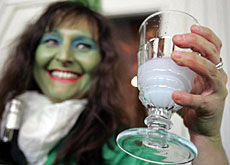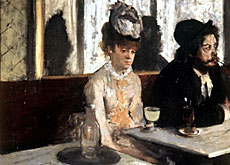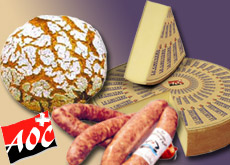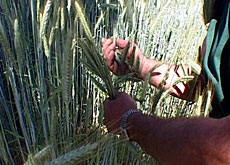“Green Fairy” comes out of hiding

The sale and production of absinthe has become legal in Switzerland, nearly a century after voters decided to prohibit the mythical liquor.
In Val-de-Travers, where bootleg versions have been made over the years, locals celebrated its new freedom. But others regret they no longer have the thrill of drinking an outlawed tipple.
Ludivines, the “Green Fairy” of absinthe, was symbolically removed on Tuesday from the police station in the town of Môtiers in the Jura mountains.
Surrounded by officers, she was released from a cage on the village square.
March 1 is the first time since 1908 that locals have been able to celebrate a regional holiday with a glass of absinthe, or “Green Fairy”, as it is popularly known. Parliament voted to legalise the spirit last year, but also set guidelines for its production.
Today’s absinthe must not contain more than 35 milligrams per kilograms of thujone – a toxic substance found in absinthe’s main ingredient, dried wormwood. But not everyone is satisfied with this limit.
“It will be like drinking decaffeinated coffee,” says Pierre-André Delachaux, a history professor. “I will keep on drinking illegal absinthe until the supply dries up, then I’ll switch to whisky.”
Delachaux, who has written a number of books about absinthe, fought long and hard against the legalisation of the “Green Fairy”, claiming that it would destroy the drink’s attraction and its authenticity.
Protection
But he has given up the fight, because he sees no point in going on.
“The ban has been lifted, now we have to get a Protected Designation of Origin for absinthe so the valley doesn’t lose out to new competitors,” he told swissinfo.
The Val-de-Travers is a quiet valley in northwestern Switzerland, where the main source of income is the local watch industry.
Absinthe is therefore seen as a great opportunity by the the valley’s regional business and development association, which wants to capitalise on the area’s historical ties with the drink.
“We couldn’t ask for a Protected Designation of Origin until the ban was lifted, but we have been talking about it for some time now,” admits Julien Spacio, the association’s secretary.
It won’t be easy since the association will have to prove that the Swiss associate absinthe with the Val-de-Travers.
While historically this holds true, the locals will have a fight on their hands because other regions are also interested in the potentially lucrative absinthe market. In the Valais region another kind of absinthe has been produced for years.
“It’s essential for us to control production of absinthe in Switzerland,” Spacio told swissinfo, adding that foreign competition will also be a challenge.
“We can’t stop say, the Czechs, from producing absinthe, even if what they sell has nothing to do with our product,” said Spacio.
Myth to live on
Until recently there were between 60 and 80 clandestine distilleries in the Val-de-Travers, which lies between Neuchâtel and Yverdon.
With the ban lifted, these bootleg producers should now be able to come out into the open.
But so far, only a few have asked for an official authorisation and according to the regional business association, a few cooperatives might also gear up for business.
“Producers can get together and ask for a single authorisation,” said Spacio. “Part-time distillers can continue producing absinthe this way without worrying about commercial pressure.”
Consumers who still want the thrill of an illegal – and stronger – tipple shouldn’t despair.
Everybody in the Val-de-Travers expects some distillers to stay out the clutches of officialdom, perpetuating the myth of the “Green Fairy” in the years to come.
swissinfo, Alexandra Richard
Legend has it that absinthe was invented in 1792 by a French doctor, Pierre Ordinaire, who settled in Couvet, a small village in western Switzerland.
The drink earned a reputation for being the tipple of choice of artists and writers, among them Ernest Hemingway.
But Swiss voters, exasperated by what they saw to be widespread absinthe abuse, chose to ban it 1908.
Absinthe survived in its heartland, the Val-de-Travers, where clandestine distillers continued to produce it over the years and local authorities turned a blind eye.
The ban on the sale and production of absinthe, which was introduced in 1908, was lifted on March 1, 2005.
New legislation also sets out under what conditions absinthe can now be produced.
Legal absinthe must not contain more than 35 milligrams of thujone – the active substance found in the spirit – per kilogram of dried wormwood plant.

In compliance with the JTI standards
More: SWI swissinfo.ch certified by the Journalism Trust Initiative



You can find an overview of ongoing debates with our journalists here. Please join us!
If you want to start a conversation about a topic raised in this article or want to report factual errors, email us at english@swissinfo.ch.